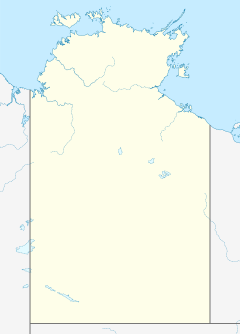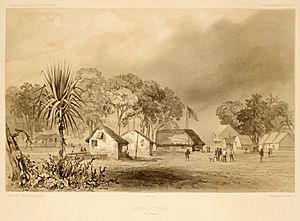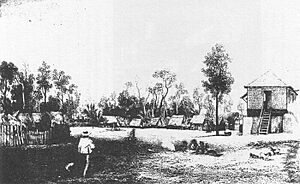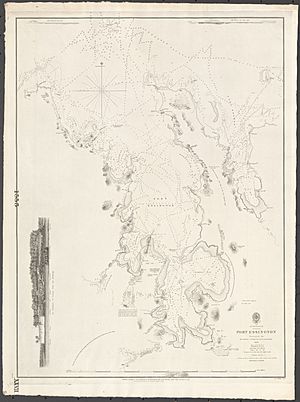Port Essington facts for kids
Port Essington is a bay and a historic place in Australia's Northern Territory. It is found on the Cobourg Peninsula inside the Garig Gunak Barlu National Park. This area was once an early British settlement. Today, only old ruins remain in this remote spot.
Contents
Early Exploration and British Plans
In August 1618, a Dutch captain named Lenaert Jacobszoon sailed past this area. He marked the entrance to what would become Port Essington on his maps. He called it Cape Turtle.
Later, in the early 1800s, the British government wanted to build a settlement. They hoped to create a trading port on Australia's northern coast. This would help them trade more easily with countries in Asia.
On April 23, 1818, Phillip Parker King named the bay Port Essington. He named it after his friend, Vice-Admiral Sir William Essington. In 1824, Sir J.G. Bremer officially claimed the land for Britain. A local Aboriginal leader named Medlone, also known as Jack Davis, helped with communication. He managed relations with the local Aboriginal people.
Building a New Settlement
Port Essington was first suggested as a settlement in 1824. However, other places like Fort Dundas and Fort Wellington were chosen instead. These first attempts did not last long.
Because of these failures, the British looked at Port Essington again. In 1838, a new settlement was started there. It was officially called Victoria Settlement, after the young Queen Victoria. But most people still called it Port Essington.
Sir J. Gordon Bremer led the building of this new settlement. Charles Tyers surveyed the area in 1839. The settlement had 24 houses and a hospital.
In 1839, a play was performed in Port Essington. It was the only play ever staged there. The play was called Cheap Living.
Challenges and Setbacks
The British government wanted Port Essington to become a big trading port like Singapore. But the new settlement faced many problems. It did not have enough resources or supplies. There were also not enough skilled workers.
Many buildings were made from local materials by unskilled builders. This meant they were often not very strong. Sickness was also common among the small group of people living there. Life was very difficult. Because of these problems, few new settlers wanted to come. The soldiers stationed there also disliked the place.
On November 25, 1839, a strong cyclone hit Port Essington. It destroyed the settlement. Twelve people died, and a ship called HMS Pelorus was pushed onto the land. The storm also caused a large flood.
After the cyclone, the settlement was rebuilt. Some new buildings were made of stone and brick. This was possible because a brick maker had been shipwrecked during the storm.
Hopes and Failures
Despite the problems, people still hoped Port Essington would succeed. For example, Ludwig Leichhardt led an expedition in 1844-1845. He successfully mapped an overland route from Moreton Bay (now Brisbane) to Port Essington. This journey was supported by the government. They hoped it would create a direct link for trade with Asia.
In 1844, a group of convicts arrived at Port Essington. Some of them were skilled masons and quarry workers. They helped build a good hospital. In 1846, Father Angelo Confalonieri started a Catholic mission nearby. He hoped to teach the local Aboriginal people about his faith. He had some success, but he died in 1848, and the mission ended.
Port Essington still struggled to attract settlers. It became clear that the settlement could not last. In December 1848, a British scientist named Thomas Henry Huxley visited. He wrote that Port Essington was "most wretched" and "unhealthy." He also said the houses were "decayed and rotten."
The End of the Settlement
Finally, in 1849, Port Essington was abandoned. It was the third British attempt to settle the north coast that failed.
Later, in 1864, there was one more unsuccessful attempt to settle the area. This was at Escape Cliffs. The first permanent settlement in the Northern Territory was finally established in 1869. This was at Darwin, which was also first known as Palmerston.
Today, the ruins of Port Essington still exist. It is difficult to get there, but you can visit by plane, four-wheel drive, or boat. You need a permit to visit, as the ruins are on Aboriginal land. You can find cabins and camping spots at Black Point Ranger Station.
The Australian industrialist Essington Lewis was named after Port Essington.
Images for kids








